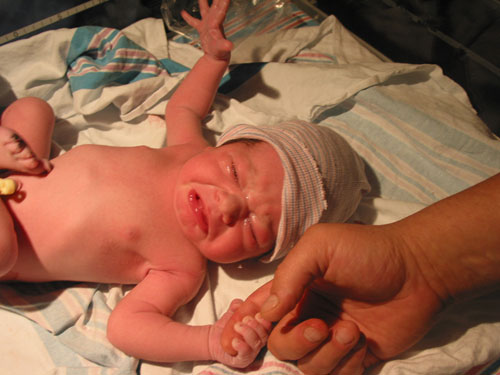Cerebral Palsy
Types of Cerebral Palsy Classified by Movement Disorder
Ataxic Cerebral Palsy

The baby above was born in perfect health. Unfortunately, not all babies are so lucky.
What is Ataxic Cerebral Palsy?
The term “Ataxia” describes the inability to coordinate voluntary muscular movements. As its name suggests, Ataxic Cerebral Palsy is characterized by low muscle tone and poor coordination of movements.
Ataxic Cerebral Palsy causes impairment and disability relating to balance and depth perception. People who suffer Ataxic Cerebral Palsy often walk in an unsteady manner, usually with a wide gait; their feet at an abnormally far distance apart from each other. In addition to problems with balance and depth perception, Ataxic Cerebral Palsy causes shaking and tremors that interfere with fine motor control. As a result, people who suffer Ataxic Cerebral Palsy also often appear very shaky. The impairment of fine motor control that results from Ataxic Cerebral Palsy can make it extremely difficult to grasp and manage small objects such as pens, keys, and silverware.
The occurrence of Ataxic Cerebral Palsy is relatively low. Most estimates are that Ataxic Cerebral Palsy affects 5-10% of those newborn babies who suffer from permanent brain damage that results in Cerebral Palsy.
[Back to Top]
Types of Medical Malpractice
Medical Malpractice during Labor and Delivery, or Shortly after Birth
Cerebral Palsy
Types of Cerebral Palsy Classified by Movement Disorder
Ataxic Cerebral Palsy
What Causes Ataxic Cerebral Palsy?
Ataxic Cerebral Palsy is caused by permanent brain damage to the cerebellum of a newborn baby, during delivery, at birth, and shortly after birth. The Cerebellum is the brain's major center for balance and coordination.
There are several factors that may contribute a newborn baby suffering from the permanent brain damage that causes Ataxic Cerebral Palsy. These factors include infection, oxygen deprivation, and Rh Disease (described above), all of which are known to cause permanent brain damage to the cerebellum of the brain of a newborn baby during delivery, at birth, and shortly after birth.
[Back to Top]
Cerebral Palsy
Types of Cerebral Palsy Classified by Movement Disorder
Ataxic Cerebral Palsy
Is There a Cure for Ataxic Cerebral Palsy?
No. There is no cure for Cerebral Palsy. Cerebral Palsy is caused by permanent brain damage to a newborn baby during delivery, at birth, and shortly after birth.
Cerebral Palsy is not a progressive condition. The permanent brain damage to a newborn baby during delivery, at birth, and shortly after birth is a one-time event. Once the brain damage is done during delivery, at birth, and shortly after birth, it is permanent and does not get worse over time.
People Cerebral Palsy can expect to live a normal life span. While the permanent brain damage caused to a baby during delivery, at birth, and shortly after birth does not worsen, the effects of the Cerebral Palsy may vary over time.
Some symptoms may improve. A child whose hands are affected by Cerebral Palsy may, over time, be able to gain enough hand control to write with a pen and dress without assistance.
Some symptoms may worsen. Muscle tightness can cause impairment to and disability of the hips and spine of a growing child with Cerebral Palsy. Sometimes, orthopedic surgery is required. In addition, Cerebral Palsy can worsen problems commonly associated with aging. The aging process is harder on bodies with abnormal posture or bodies that have had little or no physical exercise.
[Back to Top]
Where may we take you?
To learn about Birth Injuries and Delivery Malpractice, Click Here.
To learn more about Cerebral Palsy, Click Here.
To fill out our Free Online Questionnaire, Click Here.
To return the the Hurt by a Doctor homepage, Click Here.


